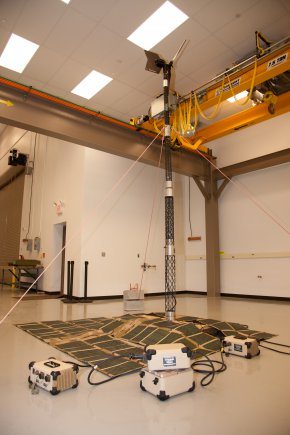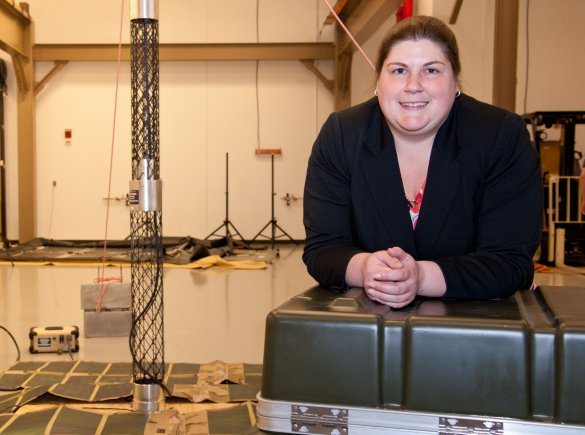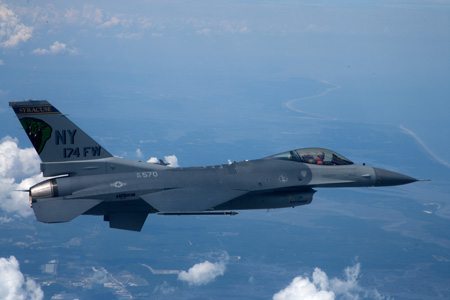Soldiers stationed in remote combat outposts face logistics and safety challenges to power their radios, laptops and GPS units.
U.S. Army scientists are researching methods to harness the sun and wind to ease the burdens associated with transporting fossil fuels to dangerous areas.
Marnie de Jong, an electrical engineer with the U.S. Army Research, Development and Engineering Command, is helping to develop renewable-energy based microgrids that work independently of traditional grid power.
Microgrids help to integrate different sources of energy for more efficient use and storage, she said.
“There has been a larger demand from the field for fuel reduction and power in remote locations,” de Jong said. “As that demand has increased, we have increased our focus in those areas.
“Microgrids will be able to take solar, wind and batteries and use them together. You can use solar when there is no wind available. Different pieces of the puzzle work better in different places. By making this a solution set, you can take what you need given your location.”
To provide alternative power sources to Soldiers in combat, de Jong and her colleagues at RDECOM’s Communications–Electronics Research, Development and Engineering Center are developing two systems — Reusing Existing Natural Energy from Wind and Solar, or RENEWS, and Renewable Energy for Distributed Undersupplied Command Environments, or REDUCE.
EASING LOGISTICS CHALLENGES
CERDEC started work on RENEWS in 2009 under an American Reinvestment and Recovery Act program for photovoltaics in which it partnered with RDECOM’s Army Research Laboratory and Natick Soldier Research, Development and Engineering Center. The team has developed RENEWS prototypes and is finishing internal testing, de Jong said.
Units are being sent for operational assessments from Soldiers at the National Training Center in Fort Irwin, Calif., and U.S. Africa Command.
“The RENEWS system is completely renewable energy [with] solar and wind components,” de Jong said. “It’s meant for smaller, mostly communications systems in very remote locations that are difficult to get to re-supply fuel or [where] it might be dangerous. It would be a self-sustaining system.”
RENEWS is designed to power two or three laptops continuously as long as there is power coming daily from the solar panels or wind turbine, she said. The storage component will be able to provide power at peak demand for about five hours when energy is not being generated by the renewable components.
The RENEWS components weight about 100 pounds, and it is stored in two cases weighing about 70 pounds each.
The Army intends the RENEWS and REDUCE systems to be complementary, resulting in power-grid technology that addresses power generation, distribution, load, renewables and storage.
A major concern for military logisticians is securing routes for fuel-truck convoys. According to Katherine Hammack, assistant secretary of the Army for installations, environment and technology, said one in 46 convoys suffers a casualty.
“There will be a reduction in fuel that is necessary for regular operations,” de Jong said. “That is one of the major concerns in the field in transporting fuel — logistics and safety. We are working to reduce fuel consumption by supplementing generators with renewable energy sources.”
INTEGRATED, INTELLIGENT POWER SYSTEMS

“The key behind the system is the intelligent power management and distribution, as well as the plug and play capability for devices. Automatic-device detection and power distribution make it a network of power systems that is capable of adjusting based on mission demands and needs,” she said.
The REDUCE integrates renewables with traditional fossil-fuel generators to reduce consumption. The goal is to ease the Soldier’s work by having the system manage all the power.
“The problem with a lot of [Army] systems is that they don’t all work together. Pieces from one don’t necessarily work with pieces from another,” de Jong said. “You can’t get two systems to parallel when they’re made from different places.
“Under the REDUCE system, we’re looking to make that all happen automatically. We [will] have an interface defined for all the systems components such that you don’t run into the problem where the different pieces don’t work together.”
UNBURDENING THE SOLDIER
Scientists and engineers across the Army focus on removing obstacles for Soldiers. By integrating smart power systems, CERDEC’s aim is to allow Soldiers to concentrate on their missions instead of monitoring power systems.
“One of the biggest challenges is getting different systems to work together,” de Jong said. “It’s really frustrating for Soldiers in the field when they just want to use this cable with this battery, and it doesn’t work. One of the major technical challenges is having standardization for interfaces and smarts that make all the pieces work seamlessly so the Soldier doesn’t have to configure anything.
“Soldiers will appreciate the plug and play capability. They don’t need to be an expert in power systems. They can just turn it on, and it gives them situational awareness into their power systems. It will report back to them what is going on and if there is a problem.”
REDUCING ENVIROMENTAL IMPACT
The RENEWS and REDUCE systems will also contribute to the Army’s goal of increasing energy efficiency and lessening the reliance on fossil fuels, she said.
“Renewable energy solutions are helping to reduce the carbon footprint. They generate energy more efficiently on-site from renewable sources. It’s good for the Army, good for the Soldier, and good for the environment,” de Jong said.











